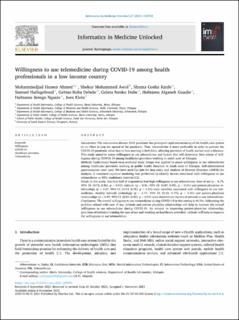| dc.contributor.author | Hassen Ahmed, Mohammedjud | |
| dc.contributor.author | Mohammed Awol, Shekur | |
| dc.contributor.author | Shuma, Gosha Kanfe | |
| dc.contributor.author | Samuel, Hailegebreal | |
| dc.contributor.author | Gebiso, Roba Debele | |
| dc.contributor.author | Geleta, Nenko Dube | |
| dc.contributor.author | Habtamu, Alganeh Guadie | |
| dc.contributor.author | Habtamu, Setegn Ngusie | |
| dc.contributor.author | Klein, Joern | |
| dc.date.accessioned | 2021-11-17T14:01:03Z | |
| dc.date.available | 2021-11-17T14:01:03Z | |
| dc.date.created | 2021-11-08T10:23:08Z | |
| dc.date.issued | 2021 | |
| dc.identifier.citation | Ahmed, M. H., Awol, S. M., Kanfe, S. G., Hailegebreal, S., Debele, G. R., Dube, G. N., Guadie, H. A., Ngusie, H. S., & Klein, J. (2021). Willingness to use telemedicine during COVID-19 among health professionals in a low income country. Informatics in Medicine Unlocked, 27, Artikkel 100783. | en_US |
| dc.identifier.issn | 2352-9148 | |
| dc.identifier.uri | https://hdl.handle.net/11250/2830138 | |
| dc.description.abstract | Introduction: The coronavirus disease 2019 pandemic has prompted rapid restructuring of the health-care system in an effort to stop the spread of the pandemic. Thus, telemedicine is more preferable in order to prevent the COVID-19 pandemic when face to face meeting is forbidden, allowing provision of health service over a distance. This study aimed to assess willingness to use telemedicine and factors that will determine their extent of willingness during COIVID-19 among healthcare providers working in south west of Ethiopia.
Methods: Institutional based cross-sectional study design was applied to assess willingness to use telemedicine among healthcare providers working at public health hospitals in south west of Ethiopia. Self-administered questionnaires were used. We have used Epi-info for data entry and Analysis of Moment Structure (AMOS) for analysis. A structural equation modeling was performed to identify factors associated with willingness to use telemedicine at 95% confidence interval (CI).
Result: In this study, less than half of respondents had high willingness to use telemedicine. Ease of use (β = 0.79, 95% CI: [0.72, 0.86], p < 0.01), attitude (β = 0.91, 95% CI: [0.87, 0.95], p < 0.01) and patient-physician relationships (β = 0.67, 95% CI: [0.54, 0.70], p < 0.01) were variables associated with willingness to use telemedicine. Anxiety towards technology (β = 0.74, 95% CI: [0.69, 0.79], p < 0.01) and patient-physician relationships (β = 0.87, 95% CI: [0.81, 0.92], p < 0.01) were determinant factors of attitude to use telemedicine.
Conclusions: The overall willingness to use telemedicine during COVID-19 in this setting is 46.5%. Addressing the problem related with ease of use, attitude and patient-physician relationships will help to increase the overall willingness to use telemedicine during COVID-19. An attempt to improving patient-physician relationship, provision of technical training for ease of use and working on healthcare providers’ attitude will help to improve the willingness to use telemedicine. | en_US |
| dc.language.iso | eng | en_US |
| dc.rights | Attribution-NonCommercial-NoDerivatives 4.0 Internasjonal | * |
| dc.rights.uri | http://creativecommons.org/licenses/by-nc-nd/4.0/deed.no | * |
| dc.title | Willingness to use telemedicine during COVID-19 among health professionals in a low income country | en_US |
| dc.type | Peer reviewed | en_US |
| dc.type | Journal article | en_US |
| dc.description.version | publishedVersion | en_US |
| dc.rights.holder | © 2021 Published by Elsevier Ltd. | en_US |
| dc.source.volume | 27 | en_US |
| dc.source.journal | Informatics in Medicine Unlocked (IMU) | en_US |
| dc.identifier.doi | https://doi.org/10.1016/j.imu.2021.100783 | |
| dc.identifier.cristin | 1952210 | |
| dc.source.articlenumber | 100783 | en_US |
| cristin.ispublished | true | |
| cristin.fulltext | original | |
| cristin.qualitycode | 1 | |

